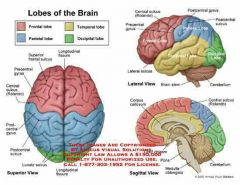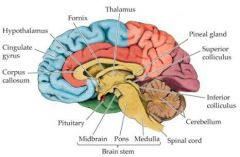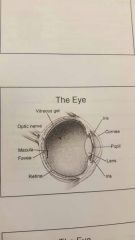![]()
![]()
![]()
Use LEFT and RIGHT arrow keys to navigate between flashcards;
Use UP and DOWN arrow keys to flip the card;
H to show hint;
A reads text to speech;
21 Cards in this Set
- Front
- Back
|
CNS and PNS |
Central Nervous System (CNS) Composed of the brain and spinal cord. Your brain and spinal cord serve as the main "processing center" for the entire nervous system, and control all the workings of your body Peripheral Nervous System (PNS) Contains all the nerves in the body that lie outside of the spinal cord and brain. The primary role of the peripheral nervous system is to connect the central nervous system to the organs, limbs, and skin to allow for complex movements and behaviors. |
|
|
Function of parietal lobe temporal lobe occipital lobe cerebellum brain stem sensory cortex |

•Parietal Lobe: visual attention, touch perception, voluntary movements, manipulation of objects, integration of different senses that allows for understanding a single concept
•Temporal Lobe: hearing ability, memory acquisition, some visual perceptions, categorization of objects
•Occipital Lobe: Vision
•Cerebellum: Coordination of voluntary movement Balance and equilibriumSome memory for reflex motor acts
•Brain Stem: Breathing, Heart Rate, Swallowing, Reflexes to seeing and hearing (Startle Response), Controls sweating, blood pressure, digestion, temperature (Autonomic Nervous System)Affects level of alertness, Ability to sleepSense of balance (Vestibular Function)
•Sensory Cortex |
|
|
Function of hypothalamus hippocampus pons medulla oblongata bronco's area sulcus |

•Hypothalamus: to link the nervous system to the endocrine system via the pituitary gland •Hippocampus: memory, in particular long-term memory. The organ also plays an important role in spatial navigation. •Pons: •Medulla Oblongata: helps regulate breathing, heart and blood vesselfunction, digestion, sneezing, and swallowing. •Brocca's Area: producing speech, writing, and also in language processing and comprehension. •Sulcus: |
|
|
What is a sensory neuron association neuron motor neuron efferent neuron interneuron |
•Sensory Neuron nerve cells that transmit sensory information (sight, sound, feeling, etc) Association Neuron Neurons found in the brain and spinal cord that conduct impulses between neurons • Motor Neuron a nerve cell forming part of the pathway along which impulse is passed from the brain or spinal cord to a muscle or gland •Efferent Neuron nerves that carry signals away from the central nervous system in order to initiate an action •Interneuron a neuron that transmits impulses between other neurons especially as a part of a reflex |
|
|
Be able to label a neuron |

|
|
|
ENDOCRINE SYSTEM |
Endocrine System The glands and parts of that glands that produce endocrine secretions, help to integrate and control bodily metabolic activit, and include especially the pituitary, thyroid, parathyroid, adrenals, islets of Langerhans, ovaries, and testes
Endocrine Gland A gland (as the thyroid and the pituitary) that produces an endocrine secretion - called also ductless gland, gland of internal secretion
Exocrine Gland A gland (as a sweat gland, a salivary gland, or a kidney) that releases a secretion external to or at the surface of an organ by means of a canal or duct
Glucagon A protein hormone that is produced especially by the pancreatic islets of Langerhans and that promotes an increase in sugar content of the body by increasing the rate of breakdown of glycogen in the liver Hypothalamus The ventral part of the vertebrate forebrain; functions and maintaining homeostasis, especially in coordinating the endocrine and nervous systems; secretes hormones of the posterior pituitary and releasing factors, which regulate the anterior pituitary Pituitary gland An endocrine gland at the base of the hypothalamus; consists of a posterior lobe, which stores and releases two hormones produced by the hypothalamus, and an anterior lobe, which produces and secretes any hormones that regulate diverse body functions |
|
|
HORMONES |
Any one of the many circulating chemical signals found in all multi-cellular organisms that are formed in specialized cells, travel in body fluids and coordinate the various parts of the organisms by interacting with target cells Hormones are secreted by tissues in the body referred to as glands Endocrine glands secrete hormones directly into the bloodstream while exocrine glands secrete hormones into ducts, or passageways, before they reach their target |
|
|
Endocrine gland that stores and releases two hormones produced by the hypothalamus |
Posterior pituitary gland |
|
|
What hormone is produced in the pancreas and increase sugar content in the body by breaking down glycogen in the liver |
Glucagon |
|
|
What secretes hormones that regulate the anterior pituitary and from the posterior pituitary |
The hypothalamic |
|
|
Describe how the body maintains homeostasis when levels of thyroid hormones decrease in the body |
The nervous and endocrine systems exert the ultimate control overhomeostasis because they coordinate the functions of the body's systems. Regulation of body temperature, blood pressure, pH, and glucose concentration are four examples of how the body maintains homeostasis. |
|
|
HORMONE IMBALANCE AND FEEDBACK LOOPS |
Negative Feedback Loop the body senses an internal change and activates mechanisms that reverse or negate that change (body temperature regulation)
Positive Feedback Loop a process in which the body senses a change and activates and mechanisms that accelerate or increase that change (blood clotting) |
|
|
THE EYE |

|
|
|
THE EYE |
Accommodation the automatic adjustment of the eye for seeing at different distances affected chiefly by changes in the convexity of the crystalline lens
Astigmatism A defect of an optical system (as a lens) causing rays from a point to fail to meet in a focal point resulting in a blurred and imperfect image
Blind spot the smaller circular area in the retina where the optic nerve enters the eye that is devoid of rods and cones and is insensitive to light
Cone any of the conical photosensitive receptor cells of the vertebrate retina that function in color vision
Cornea The transparent part of the coat of the eyeball that covers the iris and pupil and admits light to the interior
Depth perception the ability to judge the distance of objects and the spatial relationship of objects at different distances
Hyperopia A condition in which visual images come to a focus behind the retina of the eye and vision is better for distant than for near objects (called also farsightedness)
Myopia a condition in which the visual images come to a focus in front of the retina of the eye because of the defects in the refractive media of the eye or of abnormal length of the eyeball resulting especially in defective vision of distant objects (called also nearsightedness)
Iris The opaque muscular contractile diaphragm that is suspended in the aqueous humor in front of the lens of the eye is perforated by the pupil and is continuous peripherally with the ciliary body, has a deeply pigmented posterior surface which excludes the enterance of light except through the pupil and a colored anterior surface which determines the color of the eyes.
Lens a curved piece of glass or plastic used singly or combined in eyeglasses or an optical instrument (as a microscope) for forming an image by focusing rays of light
Optic nerve either of the pair of sensory nerves that comprise the second pair of cranial nerves arise from the ventral part of the dienecphalon form an optic chaisma before passing to the eye and spreading over the anterior surface of the retina and conduct visual stimuli to the brain
Pupil The opening in the iris which admits light into the interior of the vertebrate eye; muscles in the iris regulate its size
Refraction The deflection from a straight path undergone by a light ray or a wave of energy and passing obliquely from one medium (as air) into another (as water or glass) in which its velocity is different
Retina The sensory membrane that lines most of the large posterior chamber of the vertebrae eye; is composed of several layers including one containing the rods and cones, and functions as the immediate instrument of vision by receiving the image formed by the lens and converting it into chemical and nervous signals that reach the brain by the way of the optic nerve
Rod Any of the Long Rod shaped photosensitive receptors in the retina responsive to faint light |
|
|
THE EYE: FOCUSING ON LIGHT |
light rays enter the eye through the cornea The iris works like a shutter in a camera after passing through the iris of light rays pass through the eyes natural crystalline lens light rays pass through a dense transparent gel-like substance called the virteous that fills the globe of the eyeball and helps the eye hold its spherical shape In a normal eye the light rays come to a sharp focusing point on the retina The retinas functions much like the film in a camera it is responsible for capturing all of the light rays, processing them into light impulses through millions of tiny nerve endings, then sending these light impulses through over a million nerve fibers to the optic nerve |
|
|
What is the difference in hyperopia and myopia |
Hyperopia : Can see things that are far but cannot clearly see things that are near Myopia : Can see things that are near but cannot see things that are fat |
|
|
What is the difference between rod and cone |
Rods : Responsible for vision at low light levels Cones : Are active at higher light levels |
|
|
What is glaucoma |
A group of eye conditions that can cause blindness A condition of increase pressure within the eyeball that can cause blindness |
|
|
How does light pass through the eye |
The light passes through the cornea, the transparent outer covering of the eye. the cornea bends or refracts the rays that pass through the a round hole called the people the iris or colored portion of the eye that surrounds the pupils, opens and closes (making the pupil bigger or smaller) to regulate the amount of light passing through. The light rays then pass through the lens which actually changes shape so it can further bend the rays and focus them on the retina at the back of the eye. |
|
|
What is cataracts |
Clouding of the normally clear lens of the eye. |
|
|
What structure in the eye contribute to the refraction of light |
Cornea |

